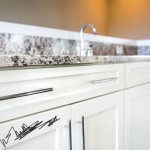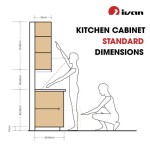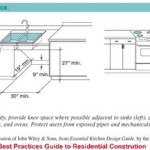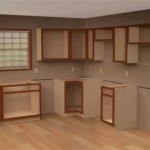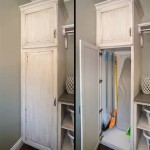How To Clean Grease Off The Top Of Kitchen Cupboards
The accumulation of grease on top of kitchen cupboards is a common household issue. The upward movement of cooking vapors, carrying microscopic oil droplets, is a primary contributor. These droplets settle on surfaces, especially elevated ones like cupboard tops, and solidify over time, trapping dust and creating a sticky, unsightly layer. This buildup not only detracts from the aesthetic appeal of the kitchen but can also become a breeding ground for bacteria and attract pests. Regular cleaning is therefore essential to maintain a clean and healthy kitchen environment. Neglecting this task for extended periods makes the grease harder to remove, requiring more intensive cleaning methods.
The cleaning process requires careful consideration of the cupboard material. Different materials react differently to cleaning agents. Wood, laminate, and painted surfaces necessitate specific approaches to avoid damage, discoloration, or removal of the finish. Harsh chemicals can strip paint, warp wood, or leave stains on laminate. Therefore, identifying the cupboard material is the critical first step in selecting the appropriate cleaning supplies and techniques.
Identifying Cupboard Material
Before commencing any cleaning activity, accurately determining the material composition of the kitchen cupboards is crucial. Solid wood cupboards often exhibit visible wood grain and a natural feel. Laminate surfaces, on the other hand, are typically smooth and uniform, lacking the texture of natural wood. Painted cupboards usually have a consistent color coating that may chip or scratch under abrasive cleaning. Examining the edges and corners of the cupboards can provide valuable clues about the underlying material. For instance, exposed particleboard or MDF suggests a laminated or veneered construction. If uncertain, consulting the manufacturer's documentation or a professional carpenter is recommended to avoid unintended damage during the cleaning process.
Once the material is definitively identified, appropriate cleaning solutions can be chosen. For solid wood, gentle cleaning agents designed for wood surfaces are ideal. Laminate can typically withstand slightly stronger cleaners, but abrasive scourers should still be avoided. Painted surfaces require extra caution and the use of mild detergents to prevent paint removal. The selection of cleaning tools, such as cloths, sponges, and brushes, should also align with the material type. Soft cloths are generally preferable for most surfaces, while gentle brushes can be used for scrubbing stubborn grease without causing scratches.
Preparation is key to an efficient and effective cleaning process. Gathering all necessary supplies beforehand minimizes interruptions and streamlines the task. This includes cleaning solutions, cloths, sponges, brushes (if needed), a step stool or ladder, protective gloves, and potentially a drop cloth or old newspapers to protect the floor and countertops from drips. Good ventilation is also important to prevent the buildup of cleaning fumes. Opening windows or turning on the kitchen exhaust fan can significantly improve air circulation during the cleaning process.
Preparing for Cleaning
Effective preparation encompasses both the selection of appropriate cleaning agents and creating a safe and efficient workspace. This involves not only gathering the necessary cleaning supplies but also taking precautions to protect oneself and the surrounding surfaces. Wearing protective gloves protects the skin from harsh cleaning chemicals and prolonged exposure to grease. Spreading a drop cloth or old newspapers on the floor and countertops beneath the cupboards prevents cleaning solutions and dislodged grease from staining or damaging those surfaces. Clearing the countertops of any appliances or items that might obstruct access to the cupboard tops is also necessary. This creates a clear and uncluttered workspace, allowing for easier maneuvering and reducing the risk of accidents. Furthermore, ensuring adequate lighting is essential for thorough cleaning. A well-lit workspace allows for better visibility, making it easier to identify and remove all traces of grease and grime.
The cleaning process itself involves a series of steps designed to effectively remove grease without damaging the cupboard surface. Starting with gentle methods and progressing to more aggressive ones as needed is generally recommended. This approach minimizes the risk of damage and ensures that the gentlest effective cleaning solution is used. Initial cleaning typically involves wiping the surface with a dry cloth or paper towel to remove loose dust and debris. This initial step prevents the dust from mixing with the cleaning solution and creating a muddy mess.
Following the initial dust removal, applying a cleaning solution is the next step. The choice of cleaning solution depends on the cupboard material and the severity of the grease buildup. A mixture of warm water and dish soap is often effective for light grease. For more stubborn grease, a solution of warm water and vinegar or a commercially available degreaser may be necessary. When using a degreaser, it is crucial to follow the manufacturer's instructions carefully and test the solution on an inconspicuous area of the cupboard first to ensure that it does not damage the finish.
The Cleaning Process
The methodical application of the chosen cleaning solution is paramount for achieving effective grease removal. This involves saturating a clean cloth or sponge with the solution and gently wiping the affected surfaces. Avoid excessive scrubbing, as this can damage the cupboard's finish. For particularly stubborn grease, allowing the cleaning solution to dwell on the surface for a few minutes before wiping can help to loosen the buildup. This dwell time allows the cleaning agents to penetrate and break down the grease, making it easier to remove. When wiping, use overlapping strokes to ensure that the entire surface is covered. Rinse the cloth or sponge frequently in clean water to remove any accumulated grease and dirt. This prevents the redeposition of grease onto the cleaned surface. After wiping with the cleaning solution, thoroughly rinse the surface with clean water to remove any residue. Leftover cleaning solution can attract dust and create a sticky film. Finally, dry the surface with a clean, dry cloth. Drying prevents water spots and helps to restore the cupboard's original luster.
After the primary cleaning process, inspection and touch-up are essential for ensuring thoroughness. Carefully examine the cleaned surfaces for any remaining grease or stains. If any stubborn spots persist, repeat the cleaning process, focusing specifically on those areas. A small amount of baking soda mixed with water can be used as a gentle abrasive for particularly challenging spots, but use caution and test on an inconspicuous area first. For intricate areas or corners, a small brush, such as an old toothbrush, can be used to gently scrub away any accumulated grease. Once satisfied with the cleanliness, apply a protective coating, such as furniture polish or wood conditioner, to the cupboards, depending on their material. This coating helps to protect the surface from future grease buildup and maintain its appearance. This is especially important for wood cupboards, which can benefit from the moisturizing properties of wood conditioner.
Maintaining clean kitchen cupboards requires a regular cleaning schedule. Frequent cleaning prevents the buildup of heavy grease and makes future cleaning tasks easier. Wiping down the cupboard tops at least once a month is recommended. This can be incorporated into a regular kitchen cleaning routine. Consider using a specialized grease-resistant spray or coating on the cupboard tops to help repel grease and make cleaning even easier. These coatings create a barrier between the grease and the cupboard surface, preventing it from adhering as strongly. Regularly inspect the cupboard tops for any signs of grease buildup and address them promptly. Early intervention is key to preventing the accumulation of stubborn grease that requires more intensive cleaning methods.

How To Clean Sticky Grease Off Kitchen Cabinets Ovenclean

How To Remove Grease From Kitchen Cabinets 3 Methods Bob Vila

How To Clean The Top Of Kitchen Cupboards 4 Simple Steps Everyday Old House

Degrease Kitchen Cabinets With An All Natural Homemade Cleaner

How To Clean The Tops Of Greasy Kitchen Cabinets Secret Tip My Pinterventures

Cleaning The Tops Of Cabinets

How To Clean The Top Of Kitchen Cupboards 4 Simple Steps Everyday Old House

How To Clean Sticky Grease Off Kitchen Cabinets

How To Remove Greasy From Kitchen Cabinets Home Cleaning Tips

How To Clean The Top Of Kitchen Cupboards 4 Simple Steps Everyday Old House
Related Posts

